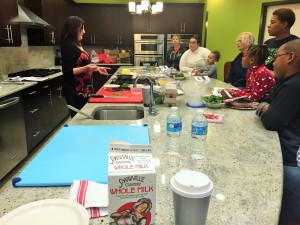Frittata Project
At North Union, we believe healthy eating is more than just access to healthy ingredients. It goes beyond availability to education, not just about the food, but how to prepare the food as well. It has become clearly evident that many families do not know how to prepare simple healthy meals. We’ve created programming with local chefs to teach them to do just that- to cook a simple, nutritive, high protein, low-cost meal.
The Frittata Project teaches young mothers (and fathers!) how to cook a nutritious meal on a budget to feed their family. The food used in the recipes we teach can be bought at our markets for around $10 (the amount we match in produce perks for EBT-SNAP/Ohio Direction Card). Workshops and demonstrations bring families together to learn how to sustain a nutritious diet while staying within their economic constraints. Our aim is to foster relationships in the community by empowering individuals to make informed decisions about the food they purchase while having the skills to prepare it. In addition to those on EBT-SNAP (Electronic Benefits Transfer- Supplemental Nutrition Assistant Program) and WIC (Women and Infant Children), the program is also open to senior citizens who participate in the Senior Farmers Market Nutrition Program by the Western Reserve Area Agency on Aging.
Our signature frittatas include farm fresh eggs, local grated cheese, a dash of grass-fed cow’s milk, and sautéed spinach seasoned with salt and pepper.
Students go home with not only new skills in the kitchen, but with cooking supplies (pan and spatula) and gift certificates for fresh and local produce from the farmers markets.
Classes take place at Cornucopia Place- Bridgeport Place, 7201 Kinsman Rd., Suite 103B Cleveland, OH 44104.
To find out more or sign up for a class please contact info@northunionfarmersmarket.org or call (216) 751-7656.
This project has been funded at least in part with Federal funds from the U.S. Department of Agriculture. The contents of this publication do not necessarily reflect the view or policies of the U.S. Department of Agriculture, nor does mention of trade names, commercial products, or organizations imply endorsement by the U.S. Government.


